+ データを開く
データを開く
- 基本情報
基本情報
| 登録情報 | データベース: PDB / ID: 6wrf | ||||||
|---|---|---|---|---|---|---|---|
| タイトル | ClpX-ClpP complex bound to GFP-ssrA, recognition complex | ||||||
 要素 要素 |
| ||||||
 キーワード キーワード | CHAPERONE / Protein degradation / AAA+ protease complex | ||||||
| 機能・相同性 |  機能・相同性情報 機能・相同性情報protein denaturation / HslUV protease complex / endopeptidase Clp / endopeptidase Clp complex / positive regulation of programmed cell death / response to temperature stimulus / ATP-dependent peptidase activity / protein quality control for misfolded or incompletely synthesized proteins / protein unfolding / proteasomal protein catabolic process ...protein denaturation / HslUV protease complex / endopeptidase Clp / endopeptidase Clp complex / positive regulation of programmed cell death / response to temperature stimulus / ATP-dependent peptidase activity / protein quality control for misfolded or incompletely synthesized proteins / protein unfolding / proteasomal protein catabolic process / serine-type peptidase activity / proteolysis involved in protein catabolic process / bioluminescence / generation of precursor metabolites and energy / ATP-dependent protein folding chaperone / response to radiation / disordered domain specific binding / unfolded protein binding / ATPase binding / response to heat / protease binding / protein dimerization activity / cell division / serine-type endopeptidase activity / ATP hydrolysis activity / proteolysis / zinc ion binding / ATP binding / identical protein binding / membrane / cytosol 類似検索 - 分子機能 | ||||||
| 生物種 |   | ||||||
| 手法 | 電子顕微鏡法 / 単粒子再構成法 / クライオ電子顕微鏡法 / 解像度: 3.14 Å | ||||||
 データ登録者 データ登録者 | Fei, X. / Sauer, R.T. | ||||||
| 資金援助 |  米国, 1件 米国, 1件
| ||||||
 引用 引用 |  ジャーナル: Elife / 年: 2020 ジャーナル: Elife / 年: 2020タイトル: Structural basis of ClpXP recognition and unfolding of ssrA-tagged substrates. 著者: Xue Fei / Tristan A Bell / Sarah R Barkow / Tania A Baker / Robert T Sauer /  要旨: When ribosomes fail to complete normal translation, all cells have mechanisms to ensure degradation of the resulting partial proteins to safeguard proteome integrity. In and other eubacteria, the ...When ribosomes fail to complete normal translation, all cells have mechanisms to ensure degradation of the resulting partial proteins to safeguard proteome integrity. In and other eubacteria, the tmRNA system rescues stalled ribosomes and adds an ssrA tag or degron to the C-terminus of the incomplete protein, which directs degradation by the AAA+ ClpXP protease. Here, we present cryo-EM structures of ClpXP bound to the ssrA degron. C-terminal residues of the ssrA degron initially bind in the top of an otherwise closed ClpX axial channel and subsequently move deeper into an open channel. For short-degron protein substrates, we show that unfolding can occur directly from the initial closed-channel complex. For longer degron substrates, our studies illuminate how ClpXP transitions from specific recognition into a nonspecific unfolding and translocation machine. Many AAA+ proteases and protein-remodeling motors are likely to employ similar multistep recognition and engagement strategies. | ||||||
| 履歴 |
|
- 構造の表示
構造の表示
| ムービー |
 ムービービューア ムービービューア |
|---|---|
| 構造ビューア | 分子:  Molmil Molmil Jmol/JSmol Jmol/JSmol |
- ダウンロードとリンク
ダウンロードとリンク
- ダウンロード
ダウンロード
| PDBx/mmCIF形式 |  6wrf.cif.gz 6wrf.cif.gz | 1.1 MB | 表示 |  PDBx/mmCIF形式 PDBx/mmCIF形式 |
|---|---|---|---|---|
| PDB形式 |  pdb6wrf.ent.gz pdb6wrf.ent.gz | 932.9 KB | 表示 |  PDB形式 PDB形式 |
| PDBx/mmJSON形式 |  6wrf.json.gz 6wrf.json.gz | ツリー表示 |  PDBx/mmJSON形式 PDBx/mmJSON形式 | |
| その他 |  その他のダウンロード その他のダウンロード |
-検証レポート
| 文書・要旨 |  6wrf_validation.pdf.gz 6wrf_validation.pdf.gz | 1.2 MB | 表示 |  wwPDB検証レポート wwPDB検証レポート |
|---|---|---|---|---|
| 文書・詳細版 |  6wrf_full_validation.pdf.gz 6wrf_full_validation.pdf.gz | 1.3 MB | 表示 | |
| XML形式データ |  6wrf_validation.xml.gz 6wrf_validation.xml.gz | 91.3 KB | 表示 | |
| CIF形式データ |  6wrf_validation.cif.gz 6wrf_validation.cif.gz | 142.6 KB | 表示 | |
| アーカイブディレクトリ |  https://data.pdbj.org/pub/pdb/validation_reports/wr/6wrf https://data.pdbj.org/pub/pdb/validation_reports/wr/6wrf ftp://data.pdbj.org/pub/pdb/validation_reports/wr/6wrf ftp://data.pdbj.org/pub/pdb/validation_reports/wr/6wrf | HTTPS FTP |
-関連構造データ
- リンク
リンク
- 集合体
集合体
| 登録構造単位 | 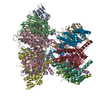
|
|---|---|
| 1 |
|
- 要素
要素
-ATP-dependent Clp protease ... , 2種, 13分子 BCDEFAHIJKLMN
| #1: タンパク質 | 分子量: 42355.812 Da / 分子数: 6 / 由来タイプ: 組換発現 由来: (組換発現)  株: K12 / 遺伝子: clpX, lopC, b0438, JW0428 / プラスミド: pacyc / 発現宿主:  #2: タンパク質 | 分子量: 23468.869 Da / 分子数: 7 / 由来タイプ: 組換発現 由来: (組換発現)  株: K12 / 遺伝子: clpP, lopP, b0437, JW0427 / 発現宿主:  |
|---|
-タンパク質 , 1種, 1分子 S
| #3: タンパク質 | 分子量: 30341.744 Da / 分子数: 1 / 由来タイプ: 組換発現 由来: (組換発現)  遺伝子: GFP / プラスミド: pet / 発現宿主:  |
|---|
-非ポリマー , 4種, 18分子 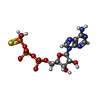






| #4: 化合物 | ChemComp-AGS / #5: 化合物 | ChemComp-MG / #6: 化合物 | ChemComp-ADP / | #7: 水 | ChemComp-HOH / | |
|---|
-詳細
| 研究の焦点であるリガンドがあるか | N |
|---|
-実験情報
-実験
| 実験 | 手法: 電子顕微鏡法 |
|---|---|
| EM実験 | 試料の集合状態: PARTICLE / 3次元再構成法: 単粒子再構成法 |
- 試料調製
試料調製
| 構成要素 | 名称: ClpX-ClpP-GFPssrA-ATP/ATPrS complex during target recognition タイプ: COMPLEX / Entity ID: #1-#3 / 由来: RECOMBINANT | ||||||||||||||||||||
|---|---|---|---|---|---|---|---|---|---|---|---|---|---|---|---|---|---|---|---|---|---|
| 分子量 | 実験値: NO | ||||||||||||||||||||
| 由来(天然) | 生物種:  | ||||||||||||||||||||
| 由来(組換発現) | 生物種:  | ||||||||||||||||||||
| 緩衝液 | pH: 7.5 | ||||||||||||||||||||
| 緩衝液成分 |
| ||||||||||||||||||||
| 試料 | 包埋: NO / シャドウイング: NO / 染色: NO / 凍結: YES 詳細: rapid mixing of ClpX, ClpP, ATPrS with GFPssrA substrate and ATP. | ||||||||||||||||||||
| 試料支持 | グリッドの材料: COPPER / グリッドのサイズ: 300 divisions/in. / グリッドのタイプ: Quantifoil R2/2 | ||||||||||||||||||||
| 急速凍結 | 装置: FEI VITROBOT MARK IV / 凍結剤: ETHANE / 湿度: 95 % / 凍結前の試料温度: 298 K |
- 電子顕微鏡撮影
電子顕微鏡撮影
| 実験機器 |  モデル: Talos Arctica / 画像提供: FEI Company |
|---|---|
| 顕微鏡 | モデル: FEI TALOS ARCTICA |
| 電子銃 | 電子線源:  FIELD EMISSION GUN / 加速電圧: 200 kV / 照射モード: OTHER FIELD EMISSION GUN / 加速電圧: 200 kV / 照射モード: OTHER |
| 電子レンズ | モード: BRIGHT FIELD / 倍率(公称値): 45000 X / 最大 デフォーカス(公称値): -2500 nm / 最小 デフォーカス(公称値): -800 nm / アライメント法: COMA FREE |
| 試料ホルダ | 凍結剤: NITROGEN 試料ホルダーモデル: FEI TITAN KRIOS AUTOGRID HOLDER |
| 撮影 | 平均露光時間: 60 sec. / 電子線照射量: 54 e/Å2 / フィルム・検出器のモデル: GATAN K3 (6k x 4k) / 撮影したグリッド数: 1 / 実像数: 4525 |
- 解析
解析
| EMソフトウェア |
| |||||||||||||||||||||||||||||||||||||||||||||||||||||||
|---|---|---|---|---|---|---|---|---|---|---|---|---|---|---|---|---|---|---|---|---|---|---|---|---|---|---|---|---|---|---|---|---|---|---|---|---|---|---|---|---|---|---|---|---|---|---|---|---|---|---|---|---|---|---|---|---|
| CTF補正 | タイプ: PHASE FLIPPING AND AMPLITUDE CORRECTION | |||||||||||||||||||||||||||||||||||||||||||||||||||||||
| 対称性 | 点対称性: C1 (非対称) | |||||||||||||||||||||||||||||||||||||||||||||||||||||||
| 3次元再構成 | 解像度: 3.14 Å / 解像度の算出法: FSC 0.143 CUT-OFF / 粒子像の数: 139817 / クラス平均像の数: 1 / 対称性のタイプ: POINT | |||||||||||||||||||||||||||||||||||||||||||||||||||||||
| 原子モデル構築 | プロトコル: RIGID BODY FIT / 空間: REAL | |||||||||||||||||||||||||||||||||||||||||||||||||||||||
| 原子モデル構築 | PDB-ID: 6PO1 Accession code: 6PO1 / Source name: PDB / タイプ: experimental model |
 ムービー
ムービー コントローラー
コントローラー








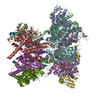
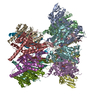
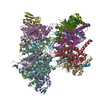

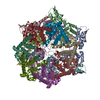


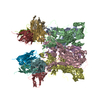
 PDBj
PDBj









